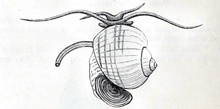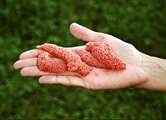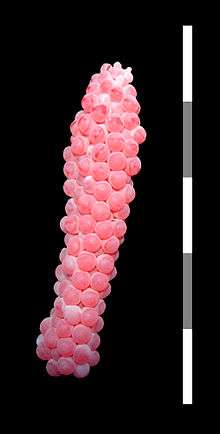Pomacea canaliculata
| Pomacea canaliculata | |
|---|---|
| | |
| Five views of a shell of Pomacea canaliculata, Shell diameter 8 cm | |
| Scientific classification | |
| Kingdom: | Animalia |
| Phylum: | Mollusca |
| Class: | Gastropoda |
| (unranked): | clade Caenogastropoda informal group Architaenioglossa |
| Superfamily: | Ampullarioidea |
| Family: | Ampullariidae |
| Genus: | Pomacea |
| Subgenus: | Pomacea |
| Species: | Pomacea canaliculata (Lamarck, 1819) |
Pomacea canaliculata, common name the channeled applesnail, is a species of large freshwater snail with gills and an operculum, an aquatic gastropod mollusk in the family Ampullariidae, the apple snails. South American in origin, this species is considered to be in the top 100 of the "World's Worst Invasive Alien Species".[2]
Shell description
The shells of these applesnails are globular in shape. Normal coloration typically includes bands of brown, black, and yellowish-tan; color patterns are extremely variable. Albino and gold color variations exist.[3][4]
The size of the shell is up to 150 mm in length.[4]
Distribution
The native distribution of P. canaliculata is basically tropical and subtropical,[5] including Argentina, Bolivia, Paraguay, Uruguay, and Brazil.[6] The southernmost record for the species is Paso de las Piedras reservoir, south of the Buenos Aires province, Argentina.[7]

Non-indigenous distribution
This species also occurs in the United States, where the initial introductions were probably from aquarium release, aka "aquarium dumping". The non-indigenous distribution includes: Lake Wawasee in Kosciusko County, Indiana;[8] Langan Park and Three Mile Creek in Mobile, Alabama;[9][10] a pond bordering the Mobile-Tensaw River Delta in Baldwin County, Alabama;[10] Little Wekiva River, Orlando, Florida; a lake near Jacksonville, Florida;[11] Miramar Reservoir in San Diego County, California; and a pond near Yuma, Arizona. Established populations exist in California and Hawaii.[4]
The species has been found in China since 1981.[12] Its initial point of distribution in China was Zhongshan city.[13]
The species has been found in Chile since 2009 with a restricted distribution.[14]
Ecology
Habitat
This species lives in freshwater habitats.
Feeding habits
Pomacea canaliculata is extremely polyphagous, feeding on vegetal (primarily macrophytophagous, feeding on floating or submersed higher plants), detrital, and animal matter. Diet may vary with age, with younger smaller individuals feeding on algae and detritus, and older, bigger (15mm and above) individuals later shifting to higher plants.[15]
This species negatively impacts rice and taro agriculture worldwide where it has been introduced.[4]
Life cycle


In temperate climates, the egg-laying period of this species extends from early spring to early fall.[16] while in tropical areas reproduction is continuous. The duration of the reproductive period of P. canaliculata decreases with latitude, to a minimum of six months in the southern limit of its natural distribution.[7]
First direct evidence (of all animals), that proteinase inhibitor from eggs of Pomacea canaliculata interacts as trypsin inhibitor with protease of potential predators, has been reported in 2010.[17]
Predators
The snail kite, Rostrhamus sociabilis, is a predator of this species in South America. The fire ant, Solenopsis geminata, has also been observed to prey upon this species.[18]
Parasites
Approximately 1% of the Pomacea canaliculata on sale on local markets in Dali City, Yunnan, China were found to be infected with Angiostrongylus cantonensis in 2009.[19]
Control
Crude cyclotide extracts from both Oldenlandia affinis and Viola odorata plants showed molluscicidal activity comparable to the synthetic molluscicide metaldehyde.[20]
Human use
This species is edible. Pomacea canaliculata constitutes one of the three predominant freshwater snails found in Chinese markets.[21] In China and Southeast Asia, consumption of raw or undercooked snails of Pomacea canaliculata and other snails is the primary route of infection with Angiostrongylus cantonensis causing angiostrongyliasis.[19]
In Isan, Thailand these snails are collected and consumed. They are picked by hand or with a hand-net from canals, swamps, ponds, and flooded paddy fields during the rainy season. During the dry season when these snails are concealed under dried mud, collectors use a spade to scrape the mud in order to find them. The snails are usually collected by women and children.[22] After collection, the snails are cleaned and parboiled. They are then taken out of their shells, cut, and cleaned in salted water. After rinsing with water, they are mixed with roasted rice, dried chili pepper, lime juice, and fish sauce, and then eaten.[22]
Pomacea canaliculata has displaced some of the indigenous rice field snail species traditionally eaten in Thailand such as Chinese mystery snail, Pila ampullacea and Pila pesmei.[23]
See also
References
This article incorporates public domain text from reference [4] and CC-BY-2.0 text from reference [22] and CC-BY-2.5 text from reference.[19]
- ↑ Pastorino, G. & Darrigan, G. (2012). "Pomacea canaliculata". IUCN Red List of Threatened Species. Version 2012.2. International Union for Conservation of Nature. Retrieved 1 December 2012.
- ↑ 100 of the World's Worst Invasive Alien Species. Global Invasive Species Database http://www.issg.org/database, accessed 27 October 2008.
- ↑ Howells, R. Personal communication. Texas Parks and Wildlife Department. In: United States Geological Survey. 2008. Pomacea canaliculata. USGS Nonindigenous Aquatic Species Database, Gainesville, FL. Revision Date: 2/4/2008
- 1 2 3 4 5 United States Geological Survey. 2008. Pomacea canaliculata. USGS Nonindigenous Aquatic Species Database, Gainesville, FL. Revision Date: 2/4/2008
- ↑ Ihering H. (1919). "Las especies de Ampullaria' en la Argentina". I Reunión Nac Soc Arg Cs Nat (Actas): 329-350, Tucumán, Argentina.
- ↑ Cowie R. H., Thiengo S. C. (2003): The apple snails of the Americas (Mollusca: Gastropoda: Ampullariidae: Asolene, Felipponea, Marisa, Pomacea, Pomella): a nomenclatural and type catalog. Malacologia, 45:41-100
- 1 2 Martín P. R., Estebenet A. L., Cazzaniga N. J. (2001). Factors affecting the distribution of Pomacea canaliculata (Gastropoda: Ampullariidae) along its southernmost natural limit. Malacologia 43: 13-23.
- ↑ "Channeled Applesnail." Aquatic Invasive Species. Indiana Department of Natural Resources, 16 June 2005. Web. 9 Nov. 2013. <http://www.in.gov/dnr/files/CHANNELED_APPLE_SNAIL.pdf>.
- ↑ D. Shelton, pers. comm. In: United States Geological Survey. 2008. Pomacea canaliculata. USGS Nonindigenous Aquatic Species Database, Gainesville, FL. Revision Date: 2/4/2008
- 1 2 Ben Raines (29 January 2011). "Amazonian apple snails found in Baldwin pond". Press Register. Retrieved 17 February 2011.
- ↑ J. Bernatis, pers. comm. In: United States Geological Survey. 2008. Pomacea canaliculata. USGS Nonindigenous Aquatic Species Database, Gainesville, FL. Revision Date: 2/4/2008
- ↑ doi/10.1371/journal.pntd.0000368.g004 map of distribution in 2007
- ↑ Lv S., Zhang Y., Liu H-X., Hu L., Yang K', et al. 2009. Invasive Snails and an Emerging Infectious Disease: Results from the First National Survey on Angiostrongylus cantonensis in China. PLoS Neglected Tropical Diseases 3(2): e368. doi:10.1371/journal.pntd.0000368 doi/10.1371/journal.pntd.0000368.g004 figure 4.
- ↑ Jackson, Douglas; Jackson Donald (2009). "Registro de Pomacea canaliculata (LAMARCK, 1822) (AMPULLARIIDAE), molusco exótico para el norte de Chile". Gayana. 73 (1): 40–44. doi:10.4067/s0717-65382009000100006.
- ↑ Estebenet, A. L. & Martín, P. R. (2002). Pomacea canaliculata (Gastropoda: Ampullariidae): Life-history Traits and their Plasticity. Biocell, 26(1): 83-89. ISSN 0327-9545
- ↑ Bachmann, A. (1960). Apuntes para una hidrobiología argentina. II. Ampullaria insularum Orb. y A. canaliculata Lam. (Moll. Prosobr., Ampullaridae). Observaciones biológicas y ecológicas. I Congr Sudamer Zool (Actas): 19-26, La Plata, Argentina.
- ↑ Dreon M. S., Ituarte S. & Heras H. (2010). "The Role of the Proteinase Inhibitor Ovorubin in Apple Snail Eggs Resembles Plant Embryo Defense against Predation". PLoS ONE 5(12): e15059. doi:10.1371/journal.pone.0015059.
- ↑ Yusa, Y, 2001. Predation on eggs of the apple snail Pomacea canaliculata (Gastropoda: Ampullaridae) by the fire ant Solenopsis geminata. Journal of Molluscian Studies, 67: 275-279
- 1 2 3 Lv, Shan; Yi Zhang; Shao-Rong Chen; Li-Bo Wang; Wen Fang; Feng Chen; Jin-Yong Jiang; Yuan-Lin Li; Zun-Wei Du; Xiao-Nong Zhou (22 September 2009). Graeff-Teixeira, Carlos, ed. "Human Angiostrongyliasis Outbreak in Dali, China". PLoS Neglected Tropical Diseases. 4 (9): e520. doi:10.1371/journal.pntd.0000520. PMC 2739427
 . PMID 19771154.
. PMID 19771154.
- ↑ Plan MR, Saska I, Cagauan AG, Craik DJ"Backbone cyclised peptides from plants show molluscicidal activity against the rice pest Pomacea canaliculata (golden apple snail)." J Agric Food Chem. 2008 Jul 9;56(13):5237-41
- ↑ Lv S., Zhang Y., Steinmann P. &, Zhou X.-N. (2008). "Emerging angiostrongyliasis in mainland China". Emerging Infectious Diseases 14(1): 161-164. HTM.
- 1 2 3 Setalaphruk, C; Price, L. L. (2007). "Children's traditional ecological knowledge of wild food resources: a case study in a rural village in Northeast Thailand". Journal of Ethnobiology and Ethnomedicine. 2007 (3): 33. doi:10.1186/1746-4269-3-33.
- ↑ Heavy Predation on Freshwater Bryozoans by the Golden Apple Snail, Pomacea canaliculata Lamarck, 1822 (Ampullariidae); The Natural History Journal of Chulalongkorn University 6(1): 31-36, May 2006
Further reading
| Wikinews has related news: South American channeled apple snail discovered in Georgia |
- Robert H. Cowie & & IUCN/SSC Invasive Species Specialist Group (ISSG). (Last Modified: Wednesday, 13 April 2005) Global Invasive Species Database, 2008. Pomacea canaliculata. Available from: http://www.issg.org/database/species/ecology.asp?si=135&fr=1&sts=sss, accessed 27 October 2008.
- Levin. 2006. Statewide strategic control plan for apple snail (Pomacea canaliculata) in Hawaii
External links
| Wikimedia Commons has media related to Pomacea canaliculata. |
- doi/10.1371/image.pntd. v03.i02.g001 photo of eggs of Pomacea canaliculata
- http://www.applesnail.net/content/species/pomacea_canaliculata.htm
